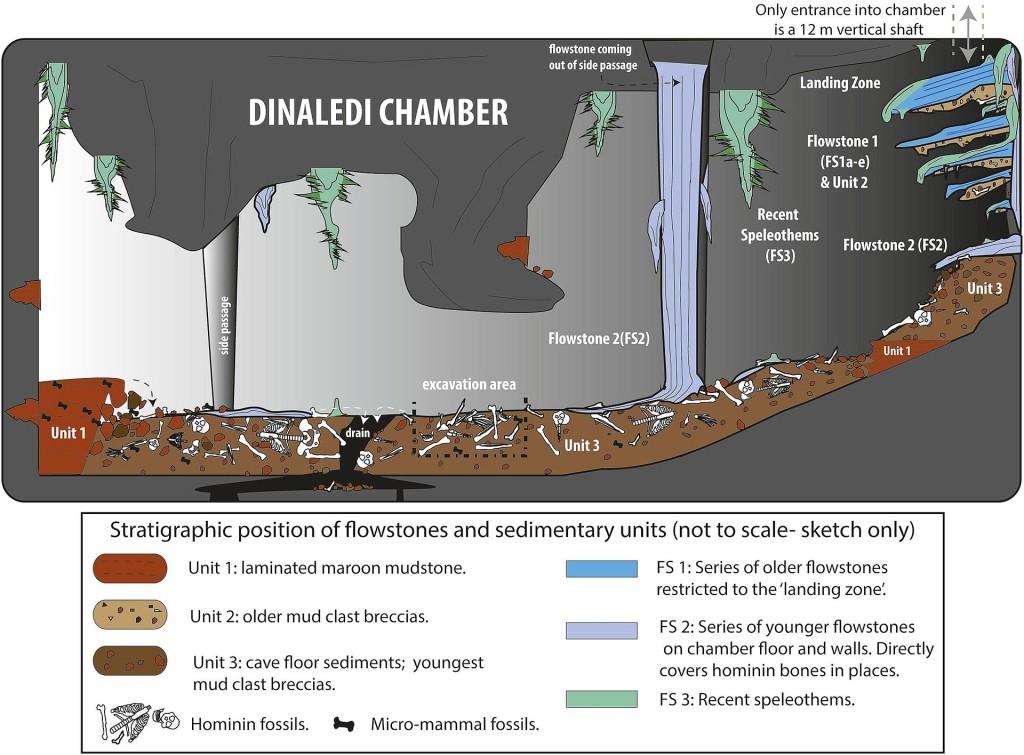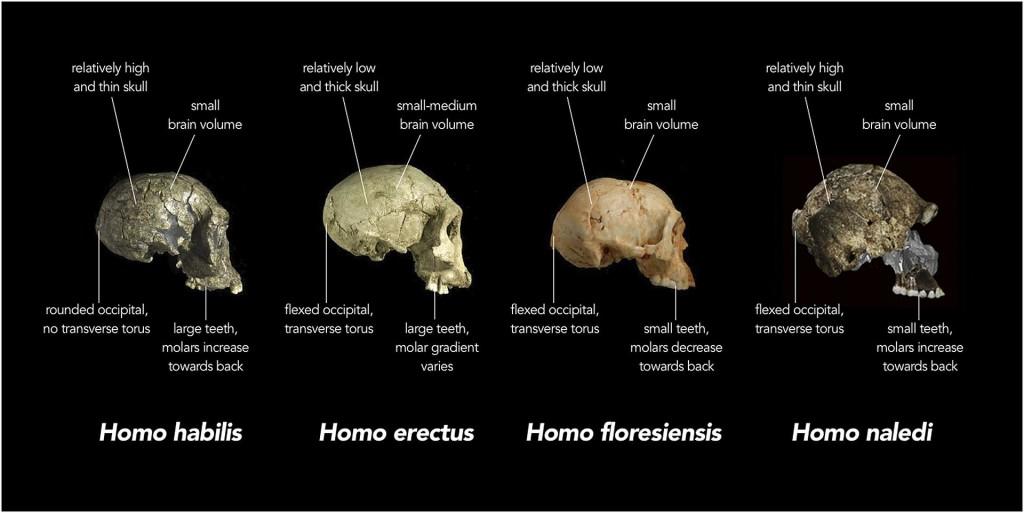In 2013, recreational cavers Rick Hunter and Steven Tucker decided to squeeze themselves through an 8″ vertical chute for a distance of nearly 40 feet in the Rising Star cave system. For their efforts, which are making me feel claustrophobic simply recounting, they were rewarded with entry into an underground ‘room’ that contained an extraordinary number of bones.

By Paul H. G. M. Dirks et al – https://elifesciences.org/content/4/e09561, CC BY 4.0, https://commons.wikimedia.org/w/index.php?curid=43091783
Luckily, these men were not just daring but also intelligent and they recognized that the bones might be of interest. They reported their find and two years later an international research team was able to release a formal description, labeling it as representing a heretofore unknown member of the Homo species. The creatures represented by the 1,550 recovered skeletal fragments has been given the name Homo Naledi, because the word “naledi” means “star” in the local Sotho language, and they were discovered in the chamber of stars within the Rising Star cave system.

By Chris Stringer, Natural History Museum, United Kingdom – Stringer, Chris (10september 2015). “The many mysteries of Homo naledi”. eLife 4: e10627. DOI:10.7554/eLife.10627. PMC: 4559885. ISSN 2050-084X., CC BY 4.0, https://commons.wikimedia.org/w/index.php?curid=43130024
Because of the narrowness of the opening to the chamber, most members of the excavating team were women, something that is relatively rare. What is even more rare is that rather than holding all of the data to themselves, they decided to release it all online so that it would be accessible to anyone interested in seeing it. This is especially helpful as the cave system itself is nearly impossible to access, and it has meant that Jennifer Webb, a student of biological anthropology at Central Michigan University, can use that data as part of her senior thesis research.

By Lee Roger Berger research team – https://elifesciences.org/content/4/e09560, CC BY 4.0, https://commons.wikimedia.org/w/index.php?curid=43071595
For her project, Webb proposes to compare the fossils found in the Rising Star cave system to later fossils of homonids to get a better understanding of what relationships there might be that could help to place these newly discovered beings on a timeline of Homo history. She will be able to do this by recreating the fossils she needs in the 3D printing lab at CMU’s MakerBot Innovation Center. Rachel Caspari, Webb’s advisor and chair of the Department of Sociology, Anthropology, and Social Work, explained the importance of being able to print her own models from open source data:
“The site itself is almost impossible to get into. You would have to travel through difficult terrain and crawl through a gap about 8 inches wide. Hopefully, this [open-access] will change the culture and other scientists will operate with much more openness.”
The printers have generally been the playground for art and design students, but an increasingly wide variety of disciplinary backgrounds are becoming regular parts of the 3D print community at CMU. As the realization of their potential grows, more people are interested in utilizing them and luckily Larry Burditt, the chair of art and design, tries his best to create a welcoming atmosphere for all who are interested.

Jennifer Webb compares various types of teeth to determine non-metric characteristics. [Image: Richard Drummond, Jr]
She also doesn’t plan on holding all of the information to herself, but rather hopes to be able to present her findings at the American Anthropological Association meeting this November. Discuss your thoughts on this amazing find and use of technology in the 3D Printing Homo Naledi forum over at 3DPB.com.
Subscribe to Our Email Newsletter
Stay up-to-date on all the latest news from the 3D printing industry and receive information and offers from third party vendors.
You May Also Like
Profiling a Construction 3D Printing Pioneer: US Army Corps of Engineers’ Megan Kreiger
The world of construction 3D printing is still so new that the true experts can probably be counted on two hands. Among them is Megan Kreiger, Portfolio Manager of Additive...
US Army Corps of Engineers Taps Lincoln Electric & Eaton for Largest 3D Printed US Civil Works Part
The Soo Locks sit on the US-Canadian border, enabling maritime travel between Lake Superior and Lake Huron, from which ships can reach the rest of the Great Lakes. Crafts carrying...
Construction 3D Printing CEO Reflects on Being Female in Construction
Natalie Wadley, CEO of ChangeMaker3D, could hear the words of her daughter sitting next to her resounding in her head. “Mum, MUM, you’ve won!” Wadley had just won the prestigious...
1Print to Commercialize 3D Printed Coastal Resilience Solutions
1Print, a company that specializes in deploying additive construction (AC) for infrastructure projects, has entered an agreement with the University of Miami (UM) to accelerate commercialization of the SEAHIVE shoreline...





























